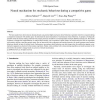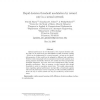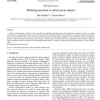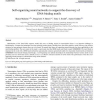105
Voted
NN
2006
Springer
15 years 18 days ago
2006
Springer
Previous studies have shown that non-human primates can generate highly stochastic choice behaviour, especially when this is required during a competitive interaction with another...
62
Voted
NN
2006
Springer
15 years 18 days ago
2006
Springer
- Since the discovery of the SOMs by T. Kohonen, many results have been found in order to get a better description of their behaviour. Most of them are very convincing but from a m...
96
Voted
NN
2006
Springer
15 years 18 days ago
2006
Springer
We introduce a new learning algorithm for topographic map formation of Edgeworth-expanded Gaussian activation kernels. In order to avoid the rapid increase in kernel parameters, a...
132
click to vote
NN
2006
Springer
15 years 18 days ago
2006
Springer
How does attention operate in natural scenes? We show that the receptive fields of inferior temporal cortex neurons that implement object representations become small and located ...
NN
2006
Springer
15 years 18 days ago
2006
Springer
Optimal performance in two-alternative, free response decision making tasks can be achieved by the drift-diffusion model of decision making - which can be implemented in a neural ...
107
click to vote
NN
2006
Springer
15 years 18 days ago
2006
Springer
The basal ganglia (BG) coordinate decision making processes by facilitating adaptive frontal motor commands while suppressing others. In previous work, neural network simulations ...
NN
2006
Springer
15 years 18 days ago
2006
Springer
Learning vector quantization (LVQ) constitutes a powerful and intuitive method for adaptive nearest prototype classification. However, original LVQ has been introduced based on he...
97
Voted
NN
2006
Springer
15 years 18 days ago
2006
Springer
Selective visual attention is believed to be responsible for serializing visual information for recognizing one object at a time in a complex scene. But how can we attend to objec...
NN
2006
Springer
15 years 18 days ago
2006
Springer
Identification of the short DNA sequence motifs that serve as binding targets for transcription factors is an important challenge in bioinformatics. Unsupervised techniques from t...
89
Voted
NN
2006
Springer
15 years 18 days ago
2006
Springer
The Generative Topographic Mapping (GTM) was originally conceived as a probabilistic alternative to the well-known, neural networkinspired, Self-Organizing Maps. The GTM can also ...




